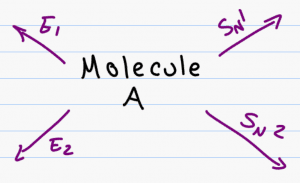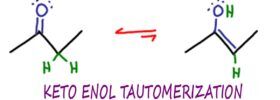
Substitution and Elimination aka SN1, SN2, E1, E2 reactions is the most difficult concept in organic chemistry 1, only second to spectroscopy in overall difficulty.
Why?
Up to this point, you learned a reaction, applied a series of reagents and conditions, and had a straightforward product. However, this topic is not as straightforward because SN1, SN2, E1, E2 reactions are often in competition with each other.
Many students turn to an SN1 SN2 E1 E2 flowchart, hoping to simplify the process, which only leads to more confusion. Instead, what we need to do is break down each reaction to understand the what and why behind it and then learn to evaluate the conditions for choosing one over the other.
This 20+ SN1 SN2 E1 E2 video series will take you through the following:

- Introduction and Overview of SN1 SN2 E1 E2 Reactions
- The SN1 Reaction and Mechanism (Unimolecular Nucleophilic Substitution)
- The SN2 Reaction and Mechanism (Bimolecular Nucleophilic Substitution)
- SN1 vs SN2 Reactions
- The E1 Reaction and Mechanism (Unimolecular Beta Elimination)
- The E2 Reaction and Mechanism (Bimolecular Beta Elimination)
- E1 vs E2 Reactions
- Choosing Between SN1 SN2 E1 E2 Reactions
- Energy Diagrams for Substitution and Elimination Reactions
- SN1 SN2 E1 E2 Practice
Feeling good about SN1 SN2 E1 E2? Download the Substitution/Elimination Cheat Sheet. Then, test your knowledge with the SN1 SN2 E1 E2 Practice Quiz.
WHY is this one of the most difficult orgo topics? How should you approach these reactions to ensure you understand? This (2 minute) introductory video explains:
Of course, if you’re already familiar with these reactions and just want a quick overview, watch the SN1 SN2 E1 E2 Reaction Mechanism Review video below for a quick overview of the individual reactions, mechanisms, and key points to look out for.
The SN1 Reaction
The SN1 reaction is a Unimolecular Nucleophilic Substitution reaction.
You can recognize that an SN1 reaction took place, as follows:
- Nucleophile sits on the carbon chain where a leaving group used to be.
- There are no strong (negative) reactants/attackers in solution.
Key points of an SN1 Reaction
All explained in the videos below.
- The reaction begins when the leaving group breaks away, forming a stable carbocation.
- Carbocation formation is a SLOW step and therefore the rate determining step of the SN1 reaction.
- When possible, a carbocation rearrangement will take place.
- A weak nucleophile attacks the carbocation.
- This nucleophile is often a solvent molecule for a solvolysis reaction.
- Deprotonation occurs in the case of neutral protonated nucleophiles such as water, alcohol or amines.
- Unimolecular means one molecule at a time for multiple steps.
- The energy diagram will contain 2 or 3 intermediate ‘humps’.
- SN1 is typically in competition with the E1 reaction for a mix of products.
SN1 Reaction Videos
- SN1 Reaction Rate and Mechanism
- SN1 Reaction Mechanism Examples
- SN1 Reaction Mechanism with Hydride Shift and Carbocation Rearrangement
- SN1 Reaction Energy Diagram
Will this proceed via an SN1 reaction?
Following the 4-part checklist below, we’re looking for the following:
- Alkyl Chain: Can support a stable carbocation – secondary, tertiary or resonance-stabilized.
- Attacker: There is a weak nucleophile present in solution, often the solution itself in a solvolysis reaction.
- Solvent: The reaction takes place in a polar protic solvent that is capable of stabilizing a carbocation.
- Leaving Group: Good leaving group present, or has the ability to bribe (protonate) a bad leaving group to make a good leaving group.
The SN2 Reaction
The SN2 reaction is a Bimolecular Nucleophilic Substitution reaction.
You can recognize that an SN2 reaction took place, as follows:
- A nucleophile sits on the molecule where a leaving group used to be.
- You have a strong nucleophile / attacker in solution.
Key points of an SN2 Reaction
All explained in the videos below.
- 2 stands for bimolecular which means 2 molecules react at the same time. This is a ONE STEP reaction.
- This reaction requires a strong (negative) nucleophile.
- This reaction prefers a polar aprotic solvent.
- No intermediate means absolutely no carbocation for an SN2 reaction.
- The energy diagram contains a single intermediate ‘hump’.
- A chiral starting molecule undergoes an inversion of configuration.
SN2 Reaction Videos
- SN2 Reaction Rate & Mechanism
- SN2 Reaction Chirality & Mechanism
- SN2 Reaction and Difficult Leaving Groups
- SN2 Reaction Energy Diagram
Is this an SN2 reaction? Look for the following on the 4-part checklist.
- Alkyl Chain: Is there steric hindrance? Methyl > 1° > 2°. SN2 cannot take place with a tertiary leaving group.
- Attacker: Strong nucleophile, typically negative.
- Solvent: Polar aprotic solvent is preferred.
- Leaving group: Must be able to kick out or bribe.
Comparing SN1 and SN2 Reactions
While SN1 and SN2 reactions appear to follow the same mechanism,
The ‘1’ type reaction (SN1) is a slow reaction with a carbocation intermediate. This can only occur in the presence of a weak nucleophile.
The ‘2’ type reaction (SN2) is a fast reaction with NO intermediate. This happens in the case of a nucleophile strong enough to kick out the leaving group, as opposed to waiting around for a carbocation to form.
For more on how to choose the appropriate mechanism based on the provided starting molecule, leaving group, reacting nucleophile and solvent, watch the video below.
And then for even more practice, watch this one:
The E1 Reaction
The E1 reaction is a Unimolecular Beta Elimination Reaction.
Recognize that an E1 reaction took place, as follows:
- There is a pi bond near where a leaving group used to reside.
- There are no strong (negative) bases in solution.
Key points of an E1 Reaction
All explained in the videos below.
- This reaction begins just like in SN1 where a leaving group breaks away to form a stable carbocation.
- Carbocation formation is SLOW, making this the rate determining step.
- If there is a more stable option, a carbocation rearrangement will occur.
- A weak base will grab a nearby hydrogen, collapsing the electrons towards the carbocation and forming a pi bond.
- The base is often the solvent for a solvolysis reaction.
- The most substituted and most stable pi bond will be the major product, following Zaitsev’s rule.
- Unimolecular means one molecule at a time for a total of TWO intermediates and therefore 2 humps on the reaction coordinate diagram.
- E1 is in competition with the SN1 reaction for a mix of products.
E1 Reaction Videos
- E1 Reaction, Rate and Mechanism
- Zaitsev’s Rule and Pi Bond Stability in E1 Reactions
- E1 Reactions with Hydride Shift and Carbocation Rearrangement
- E1 Reaction Energy Diagram
Is this an E1 Reaction?
Follow along with the 4-part checklist, as taught below.
- Alkyl Chain: Can support a stable carbocation. Has a beta hydrogen to eliminate.
- Attacker: Weak base, often the solvent for a solvolysis reaction.
- Solvent: Polar protic
- Leaving group: Good stable leaving group.
The E2 Reaction
The E2 reaction is a Bimolecular Beta Elimination Reaction.
You can recognize that an E2 reaction took place, as follows:
- There is a pi bond on the carbon that used to hold the leaving group.
- This reaction took place in the presence of a strong / negative base.
Key points of an E2 Reaction
All explained in the videos below.
- 2 stands for Bimolecular. 2 molecules reacting at the same time for a ONE step reaction.
- This reaction requires a strong / negative base.
- This reaction prefers a polar protic solvent.
- One step means NO intermediates and therefore no carbocation formation.
- The reaction coordinate diagram contains a single transition state ‘hump’.
- The more substituted hydrogen is eliminated to form the most stable pi bond, following Zaitsev’s rule.
- E2 reactions require a higher activation energy but result in a lower energy and more stable product.
- Big Bulky Bases (BBB) choose the less substituted hydrogen for a Hoffman (vs Zaitsev) product.
- Heat (see bullet above) helps stabilize and favor the E2 reaction.
E2 Reaction Videos
- E2 Reaction Rate and Mechanism
- Predict E2 Products using Newman Projections
- E2 Reactions using Chair Conformations To Identify Anti-Coplanar Relationships
- E2 Reaction with Big Bulky Base for Hoffman (Anti-Zaitsev) Product
- E2 Reaction Energy Diagram
Is this an E2 Reaction?
Follow along with the 4-part checklist below.
- Alkyl Chain: Has beta hydrogen to allow for elimination.
- Attacker: Strong (negative) base.
- Solvent: Prefers polar protic over an aprotic solvent.
- Leaving group: Good leaving group that can be kicked out.
- Heat: Helps stabilize and favors an E2 reaction.
Comparing E1 vs E2 Reactions
The E1 and E2 reactions may have the same reactant and same product, and they appear to follow the same mechanism. However…
The ‘1’ type reaction (E1) is a slow reaction with a carbocation intermediate. This is due to reacting in the presence of a weak base that awaits the leaving group's slow departure.
The ‘2’ type reaction (E2) is a fast reaction with NO intermediate. This is due to the strong base quickly attacking to kick out the leaving group.
Both reactions take place in the same polar protic solvents, but the attacking base is what ultimately sets them apart.
Choosing Between SN1 SN2 E1 E2 Reactions
Unlike most organic chemistry reactions, you cannot simply evaluate the reactant and reagent to identify the products. When it comes to substitution and elimination reactions, you have to evaluate every aspect carefully to choose between the 4 competing reactions.
Instead of memorizing an illogical roadmap, use my 4-part checklist explained here to logically reason between the 4 reactions. These are explained in detail in the videos below:
- Alkyl Chain: Can it form a carbocation? Is it too hindered for a bimolecular substitution? Do I have a beta hydrogen for elimination?
- Attacker: Look less at the nucleophile vs base and more at the strength. Do I have a strong attacker for a ‘2 type’ reaction, or a weak attacker for a ‘1 type’ reaction?
- Solvent: Do I have a polar aprotic solvent that will activate a nucleophile, or a polar protic solvent that will allow for E2, or stabilize potential carbocation intermediates?
- Leaving Group: Is it good enough to leave or get kicked out? If not, can I bribe it via protonation or turn it into a larger and more stable leaving group?
Videos in the 4-Part Checklist Series
- Alkyl Halide Carbon Chain Analysis for SN/E Reactions
- Nucleophile vs Base (Part 1 and Part 2)
- Polar Protic, Aprotic and Non-Polar Solvents
- Leaving Groups in SNE Reaction including bribing a ‘bad’ oxygen leaving group.
Ready to apply what you know? Ready to choose between reactions?
First, start with this video where I walk through the 4-part checklist in detail using examples:
Then, for even more practice, see this video where I walk through a tricky reaction from a real student's exam:
Energy Diagrams
You’ll notice heat, as a measure of activation energy, often included in substitution and elimination reactions. What exactly happens to the energy of a system undergoing substitution or elimination? How many transition states are there? How many intermediates? How many activation energy ‘humps’?
Let’s break it down in the following videos:
- SN1 Reaction Energy Diagram
- SN2 Reaction Energy Diagram
- E1 Reaction Energy Diagram
- E2 Reaction Energy Diagram
Ready to Review?
If you made it this far, congratulations! You are miles ahead of your classmates regarding this very difficult organic chemistry topic!
Ready to test your knowledge and see where you stand?
First, download my SN1 SN2 E1 E2 Cheat Sheet. Then, try the Substitution Elimination Practice Quiz and see how you do.


